-
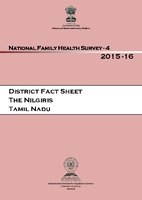 The National Family Health Survey
The National Family Health Survey The National Family Health Survey (NFHS-4) conducted in 2015-16 provides critical data on population, health, and nutrition across India, including district-level insights for The Nilgiris in Tamil Nadu. This round introduced new topics such as malaria prevention and expanded health measurements like blood pressure and glucose levels. It assessed various indicators through detailed household and individual questionnaires, revealing key trends in education, health care access, and family planning. Notably, the survey highlighted issues such as literacy rates, maternal health, child immunization, and nutritional status, which are essential for shaping health policies and programs in the region.
-
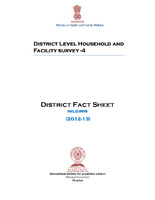 The District Level Household and Facility Survey
The District Level Household and Facility Survey The District Level Household and Facility Survey (DLHS-4) conducted in Nilgiris during 2012-2013 aimed to assess reproductive and child health indicators at a district level in India, following previous rounds in 1998, 2002, and 2007. The survey gathered data from 1,297 households and 1,010 ever-married women, focusing on socio-economic characteristics, maternal health, and immunization. Key findings indicated improvements in literacy rates, healthcare access, and family planning methods, while challenges remained in areas such as antenatal care and treatment for childhood diseases. The information is crucial for monitoring health programs and guiding policy decisions.
-
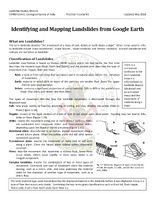 Identifying and Mapping Landslides
Identifying and Mapping Landslides The tutorial from the Geological Survey of India focuses on identifying and mapping landslides using Google Earth. Landslides, defined as the movement of rock or debris down a slope, can be classified by material type (rock, earth, debris) and movement type (fall, topple, slide, flow). The tutorial emphasizes the importance of accurately mapping landslides, including their dimensions and features, using high-resolution satellite images and historical data. It describes practical steps for measuring landslides and exporting the data for analysis in GIS software, facilitating effective landslide susceptibility mapping to understand their triggers and impacts.
-
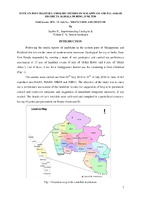 NOTE ON POST DIASTER LAND SLIDE STUDIES_Malappuram,Palakad
NOTE ON POST DIASTER LAND SLIDE STUDIES_Malappuram,Palakad In June 2018, heavy rainfall in the Malappuram and Palakkad districts of Kerala triggered multiple landslides, leading a Geological Survey of India team to assess 13 events, including debris flows and slides. The primary causes identified include slope excavation, river erosion, poor drainage maintenance, and natural geological factors. Each landslide was documented with specific attributes, revealing that many were exacerbated by prior land modifications for agriculture, which blocked natural drainage. The study recommends immediate and long-term remedial measures such as maintaining drainage systems and removing obstructive debris to prevent future incidents.
-
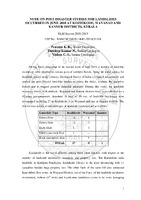 NOTE ON POST DISASTER STUDIES FOR LANDSLIDES_Wayanad
NOTE ON POST DISASTER STUDIES FOR LANDSLIDES_Wayanad In June 2018, heavy rainfall triggered multiple landslides in northern Kerala, particularly affecting the Kozhikode, Wayanad, and Kannur districts. The Geological Survey of India conducted a rapid assessment, documenting 36 landslide incidents, with Kozhikode being the most impacted, resulting in 14 fatalities and significant property damage. The landslides were primarily caused by saturated soil conditions, increased pore water pressure, and unscientific slope modifications. Key recommendations included removing precarious boulders, restoring natural drainage, and conducting detailed geological studies before further construction. The report highlights the urgent need for improved land management practices to mitigate future risks.
-
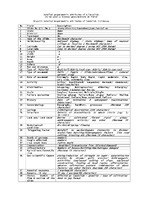 Detailed geo parametric attributes of a landslide
Detailed geo parametric attributes of a landslide The document outlines a comprehensive framework for recording detailed geoparametric attributes of landslides, intended for use by geoscientists in the field. It includes 42 specific data points such as the slide's identification number, geographical location (latitude and longitude), physical dimensions (length, width, height, area, volume), type and movement of material, activity status, geomorphological and geological context, triggering factors, and the impact on human life and infrastructure. Additionally, it emphasizes the need for remedial measures and allows for the inclusion of photographic evidence and a summary of findings, categorizing landslides into three distinct types.
-
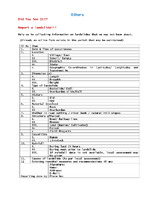 Report a landslide
Report a landslide The document provides detailed information on landslides, including reporting, classification, and components involved.
-
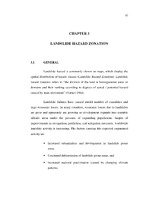 LANDSLIDE HAZARD ZONATION
LANDSLIDE HAZARD ZONATION Landslide hazard zonation (LHZ) maps are essential for identifying areas at risk of landslides, which can lead to significant casualties and economic losses, particularly as urbanization and climate change increase vulnerability. Effective LHZ involves categorizing land based on factors contributing to slope instability, including geology, topography, soil type, and land use. Various methodologies, both qualitative and quantitative, are employed to assess and predict landslide risks. Geographic Information Systems (GIS) and remote sensing enhance data collection and analysis, improving hazard mapping accuracy. Recognizing and mitigating these hazards is crucial for informed urban planning and disaster management.
-
 RAINFALL VS LANDSLIDE STUDY IN NILGIRI DISTRICT, TAMILNADU, SOUTH INDIA
RAINFALL VS LANDSLIDE STUDY IN NILGIRI DISTRICT, TAMILNADU, SOUTH INDIA The study investigates the relationship between rainfall and landslides in the Nilgiri district of Tamil Nadu, India, over a decade from 2003 to 2012. It identifies a significant correlation, indicating that heavy rainfall, particularly during the Northeast Monsoon, is a primary trigger for landslides, notably in the Coonoor and Wellington regions. Using GIS to analyze rainfall data and landslide occurrences, the research establishes that areas with higher rainfall experience more landslides, while moderate rainfall areas also face risks. The findings highlight the necessity for effective land management and disaster preparedness in this hilly terrain.
-
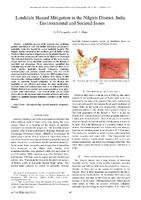 Landslide Hazard Mitigation in the Nilgiris District, India– Environmental and Societal Issues
Landslide Hazard Mitigation in the Nilgiris District, India– Environmental and Societal Issues Landslides pose a significant risk in the Nilgiris district of India, which is categorized as highly prone to such hazards, especially during the rainy season. The frequency of landslides has increased, with a devastating event in November 2009 resulting in numerous casualties and extensive property damage. Despite existing research on landslide hazards, there is a lack of effective mitigation strategies and public awareness. This study emphasizes the need for comprehensive landslide management, including the use of cost-effective soil bioengineering techniques for slope stabilization. It advocates for improved planning, community education, and restrictions on development in high-risk areas to enhance safety and resilience.
-
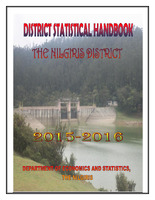 District Statistical Hand Book
District Statistical Hand Book The "District Statistical Handbook" for The Nilgiris District (2015-16) presents comprehensive data on various sectors, including demographics, geography, economy, and public services, aimed at aiding planners and researchers. The district, known for its picturesque landscapes, has a population of 735,394, with significant contributions from agriculture, mainly tea and coffee production. The tourism sector thrives due to attractions like the Botanical Garden and Doddabetta Peak. The report highlights the region's development in infrastructure, healthcare, education, and social welfare initiatives, while also acknowledging the contributions of various government and private organizations in these areas.
-
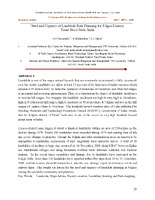 Need and Urgency of Landslide Risk Planning for Nilgiri District,Tamil Nadu State, India
Need and Urgency of Landslide Risk Planning for Nilgiri District,Tamil Nadu State, India The paper emphasizes the urgent need for effective landslide risk planning in the Nilgiri District of Tamil Nadu, India, which is highly prone to landslides due to its geographical features and heavy rainfall. Historical data indicates significant landslide incidents, particularly during extreme weather, leading to loss of life and property. It advocates for a comprehensive risk assessment framework that includes hazard recognition and the development of hazard maps to mitigate risks. The authors stress the importance of integrating scientific understanding with community engagement in planning processes to enhance safety and reduce vulnerability in landslide-affected areas.
-
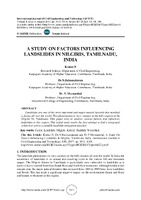 A STUDY ON FACTORS INFLUENCING LANDSLIDES IN NILGIRIS, TAMILNADU, INDIA
A STUDY ON FACTORS INFLUENCING LANDSLIDES IN NILGIRIS, TAMILNADU, INDIA The study explores the factors contributing to landslides in the Nilgiris district of Tamil Nadu, India, a region prone to such natural hazards due to heavy rainfall from monsoons and its steep topography. It identifies both natural causes, like high rainfall intensity and soil characteristics, and human-induced factors, such as deforestation and urban development, as significant contributors to landslides. The research aims to develop effective mitigation strategies by analyzing watershed characteristics, particularly in the Kattery watershed, which exemplifies the area's complex interplay of factors influencing landslide occurrences.
-
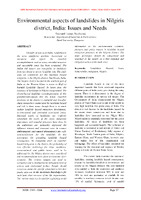 Environmental aspects of landslides in Nilgiris district, India: Issues and Needs
Environmental aspects of landslides in Nilgiris district, India: Issues and Needs The Nilgiris district in Tamil Nadu, India, faces significant landslide hazards, exacerbated by urbanization, deforestation, and inadequate drainage systems. The study identifies the region as highly susceptible to landslides, stressing the need for effective hazard mitigation strategies. Recommendations include raising public awareness, improving land-use management, and implementing bioengineering solutions for slope stabilization. The increasing frequency and severity of landslides necessitate urgent action from policymakers and community leaders to enhance safety measures and educate residents about risks. Overall, a comprehensive approach is essential to address both environmental and societal impacts of landslides in this vulnerable area.
-
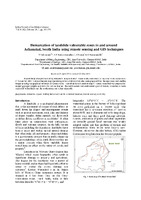 Demarcation of landslide vulnerable zones in and around Achanakal, South India using remote sensing and GIS techniques
Demarcation of landslide vulnerable zones in and around Achanakal, South India using remote sensing and GIS techniques The study focused on identifying landslide-prone areas in the Kattery watershed, Tamil Nadu, using remote sensing and GIS techniques following a significant landslide event in 2009. The researchers created various thematic maps to assess factors influencing landslide susceptibility, such as drainage patterns, slope, geology, and land use. The analysis revealed that the northeastern and southwestern regions of the watershed are the most vulnerable to landslides, while the southeastern area is less affected. A comprehensive landslide hazard zonation map was developed, categorizing regions based on their risk levels, providing valuable insights for future disaster management and mitigation efforts.
-
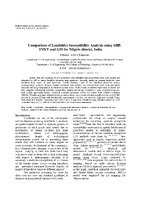 Comparison of Landslides Susceptibility Analysis using AHP, SMCE and GIS for Nilgiris district , India
Comparison of Landslides Susceptibility Analysis using AHP, SMCE and GIS for Nilgiris district , India The study conducted by S. Shanthi and Dr. K. Elangovan focuses on landslide susceptibility analysis in the Nilgiris district of India using Geographic Information Systems (GIS), Analytical Hierarchy Process (AHP), and Spatial Multi-Criteria Evaluation (SMCE). It identifies past landslide locations and relevant predictors such as geomorphology, geology, and rainfall, creating a landslide inventory map. Using AHP and SMCE, the researchers calculated weights for these predictors, generating a landslide susceptibility (LS) map categorized into five zones. The results showed that SMCE provided a more accurate representation of susceptibility zones compared to AHP, with both models validating well against historical data.
-
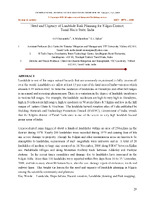 Need and Urgency of Landslide Risk Planning for Nilgiris District
Need and Urgency of Landslide Risk Planning for Nilgiris District Landslides pose a significant natural hazard in hilly regions, affecting about 15% of India's land area, particularly in the Nilgiri district of Tamil Nadu, which is highly prone to such events. Historical data shows that unprecedented rainfall has triggered numerous landslides, resulting in loss of life and extensive property damage. The urgent need for effective landslide risk planning is emphasized, advocating for hazard recognition, risk assessment, and the development of appropriate management strategies. Comprehensive hazard mapping and improved infrastructure development are necessary to mitigate risks and enhance public safety in these vulnerable areas.
-
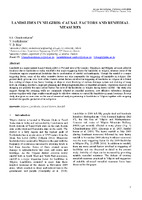 LANDSLIDES IN NILGIRIS: CAUSAL FACTORS AND REMEDIAL MEASURES
LANDSLIDES IN NILGIRIS: CAUSAL FACTORS AND REMEDIAL MEASURES Landslides in the Nilgiris region of India pose significant hazards, affecting around 15% of the area, primarily triggered by heavy rainfall. Factors contributing to these landslides include improper slope excavation, excessive loading at the slope crest, blocked drainage systems, and vegetation removal. Past instances, particularly the devastating landslides in November 2009, resulted in loss of lives and substantial infrastructure damage. The study suggests that while retaining walls are commonly used, implementing cost-effective subsurface drainage systems and slope reinforcement measures could better mitigate these risks. Ongoing research aims to enhance understanding of landslide mechanisms and develop effective, site-specific remedial strategies.
-
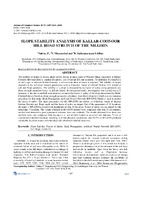 SLOPE STABILITY ANALYSIS OF KALLAR-COONOOR HILL ROAD STRETCH OF THE NILGIRIS
SLOPE STABILITY ANALYSIS OF KALLAR-COONOOR HILL ROAD STRETCH OF THE NILGIRIS The study analyzes slope stability along the Kallar-Coonoor hill road in the Nilgiris, a region prone to frequent landslides due to factors like heavy rainfall, steep slopes, and inadequate drainage. Researchers conducted geotechnical assessments at 32 locations, measuring soil parameters such as density, cohesion, and internal friction. They utilized both conventional methods and a Back Propagation Artificial Neural Network (BP-ANN) to predict the factor of safety for slope stability. The BP-ANN approach demonstrated a higher accuracy (85.7%) compared to the conventional method (71.4%), emphasizing its effectiveness in assessing landslide risks and the necessity for slope protection measures in vulnerable areas.
-
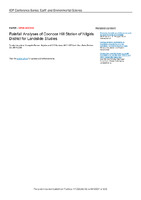 Rainfall Analyses of Coonoor Hill Station of Nilgiris District for Landslide Studies
Rainfall Analyses of Coonoor Hill Station of Nilgiris District for Landslide Studies The study analyzes rainfall patterns at Coonoor Hill Station in the Nilgiris District to assess their impact on landslide occurrences over 80 years (1935-2013). Findings indicate an increase in annual rainfall, averaging 1773 mm in recent decades, with significant variability during pre-monsoon and monsoon periods. Extreme rainfall events, particularly during the North-East monsoon, are linked to landslides, with 200 mm or more triggering substantial landslide activity. The research underscores the need for effective monitoring and preventive measures in the region, highlighting the dynamic nature of rainfall thresholds for landslide susceptibility influenced by local terrain conditions.
-
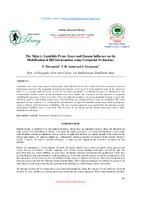 The Nilgiris: Landslide Prone Zones and Human Influence on the
Modification of Hill Environment using Geospatial Technology
The Nilgiris: Landslide Prone Zones and Human Influence on the
Modification of Hill Environment using Geospatial Technology The study examines the impact of human activities on landslide-prone areas in the Nilgiris district of Tamil Nadu, India, highlighting that economically vulnerable populations face the greatest risks from landslides. It emphasizes the need for better urban planning to avoid development in high-risk zones and improve awareness of landslide hazards among communities and policymakers. The research employs geospatial technology to map landslide occurrences and assess environmental modifications from 1990 to 2010. The findings indicate that improper land use, deforestation, and increased settlements exacerbate landslide risks, necessitating a comprehensive risk management strategy to protect the fragile ecosystem and its inhabitants.
-
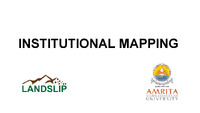 Landslip-InstitutionalMapping
Landslip-InstitutionalMapping The institutional framework for disaster management in India is structured at national, state, and district levels, with the central government supporting state efforts. Key decisions are made by top bodies like the Cabinet Committee on Security and the National Crisis Management Committee, overseeing disaster responses and resource allocation. The National Disaster Management Authority (NDMA) formulates policies and coordinates their implementation, while state authorities, such as the State Disaster Management Authority (SDMA), develop local plans and training. Local organizations and authorities play crucial roles in community preparedness, response, and recovery efforts, emphasizing a collaborative approach to disaster management.
-
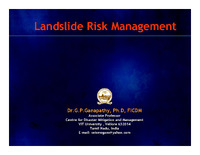 Landslide_risk_management
Landslide_risk_management Landslide risk management in India involves the assessment and zoning of areas based on their susceptibility to landslides, using methodologies like GIS analysis to prioritize factors such as slope and rainfall. Historical studies have highlighted the impact of human activities, like construction and deforestation, on landslide occurrences, particularly in regions like Nilgiris, which experienced severe landslides in 2009 due to heavy rains and unsafe development practices. Recommendations for improving safety include stricter zoning laws, enhanced monitoring of rainfall and slopes, and comprehensive planning to avoid future disasters in high-risk areas.
-
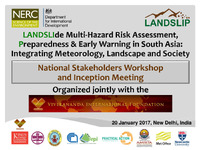 LANDSLIde Multi -Hazard Risk Assessment
LANDSLIde Multi -Hazard Risk Assessment The LANDSLIP project, launched at an inception meeting on January 20, 2017, in New Delhi, aims to enhance multi-hazard risk assessment and early warning systems for landslides in South Asia, particularly focusing on India and Afghanistan. The consortium comprises experts from nine organizations across India, Italy, and the UK, and seeks to integrate meteorology, landscape dynamics, and societal factors into its methodologies. Key objectives include developing tailored risk assessment tools, enhancing communication with stakeholders, and ensuring sustainability through knowledge sharing and capacity building in pilot areas like Darjeeling and Nilgiris.
-
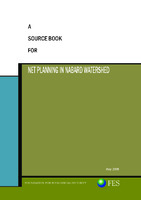 FOUNDATION FOR ECOLOGICAL SECURITY NET PLANNING IN NABARD WATERSHED
FOUNDATION FOR ECOLOGICAL SECURITY NET PLANNING IN NABARD WATERSHED The "Source Book for Net Planning in NABARD Watershed" serves as a comprehensive guide for planning soil and water conservation measures within NABARD-funded watersheds. It outlines the net planning process, including data collection, technical surveys, and the creation of treatment maps, all aimed at facilitating project proposals during the Capacity Building Phase. The guidelines detail the parameters for assessing land capability and provide simplified formats for easy data recording by field staff. Additionally, the document includes specific structural recommendations for various soil and water conservation interventions, manpower requirements for different project stages, and essential documentation needed for effective watershed management.
 The National Family Health Survey The National Family Health Survey (NFHS-4) conducted in 2015-16 provides critical data on population, health, and nutrition across India, including district-level insights for The Nilgiris in Tamil Nadu. This round introduced new topics such as malaria prevention and expanded health measurements like blood pressure and glucose levels. It assessed various indicators through detailed household and individual questionnaires, revealing key trends in education, health care access, and family planning. Notably, the survey highlighted issues such as literacy rates, maternal health, child immunization, and nutritional status, which are essential for shaping health policies and programs in the region.
The National Family Health Survey The National Family Health Survey (NFHS-4) conducted in 2015-16 provides critical data on population, health, and nutrition across India, including district-level insights for The Nilgiris in Tamil Nadu. This round introduced new topics such as malaria prevention and expanded health measurements like blood pressure and glucose levels. It assessed various indicators through detailed household and individual questionnaires, revealing key trends in education, health care access, and family planning. Notably, the survey highlighted issues such as literacy rates, maternal health, child immunization, and nutritional status, which are essential for shaping health policies and programs in the region. The District Level Household and Facility Survey The District Level Household and Facility Survey (DLHS-4) conducted in Nilgiris during 2012-2013 aimed to assess reproductive and child health indicators at a district level in India, following previous rounds in 1998, 2002, and 2007. The survey gathered data from 1,297 households and 1,010 ever-married women, focusing on socio-economic characteristics, maternal health, and immunization. Key findings indicated improvements in literacy rates, healthcare access, and family planning methods, while challenges remained in areas such as antenatal care and treatment for childhood diseases. The information is crucial for monitoring health programs and guiding policy decisions.
The District Level Household and Facility Survey The District Level Household and Facility Survey (DLHS-4) conducted in Nilgiris during 2012-2013 aimed to assess reproductive and child health indicators at a district level in India, following previous rounds in 1998, 2002, and 2007. The survey gathered data from 1,297 households and 1,010 ever-married women, focusing on socio-economic characteristics, maternal health, and immunization. Key findings indicated improvements in literacy rates, healthcare access, and family planning methods, while challenges remained in areas such as antenatal care and treatment for childhood diseases. The information is crucial for monitoring health programs and guiding policy decisions. Identifying and Mapping Landslides The tutorial from the Geological Survey of India focuses on identifying and mapping landslides using Google Earth. Landslides, defined as the movement of rock or debris down a slope, can be classified by material type (rock, earth, debris) and movement type (fall, topple, slide, flow). The tutorial emphasizes the importance of accurately mapping landslides, including their dimensions and features, using high-resolution satellite images and historical data. It describes practical steps for measuring landslides and exporting the data for analysis in GIS software, facilitating effective landslide susceptibility mapping to understand their triggers and impacts.
Identifying and Mapping Landslides The tutorial from the Geological Survey of India focuses on identifying and mapping landslides using Google Earth. Landslides, defined as the movement of rock or debris down a slope, can be classified by material type (rock, earth, debris) and movement type (fall, topple, slide, flow). The tutorial emphasizes the importance of accurately mapping landslides, including their dimensions and features, using high-resolution satellite images and historical data. It describes practical steps for measuring landslides and exporting the data for analysis in GIS software, facilitating effective landslide susceptibility mapping to understand their triggers and impacts. NOTE ON POST DIASTER LAND SLIDE STUDIES_Malappuram,Palakad In June 2018, heavy rainfall in the Malappuram and Palakkad districts of Kerala triggered multiple landslides, leading a Geological Survey of India team to assess 13 events, including debris flows and slides. The primary causes identified include slope excavation, river erosion, poor drainage maintenance, and natural geological factors. Each landslide was documented with specific attributes, revealing that many were exacerbated by prior land modifications for agriculture, which blocked natural drainage. The study recommends immediate and long-term remedial measures such as maintaining drainage systems and removing obstructive debris to prevent future incidents.
NOTE ON POST DIASTER LAND SLIDE STUDIES_Malappuram,Palakad In June 2018, heavy rainfall in the Malappuram and Palakkad districts of Kerala triggered multiple landslides, leading a Geological Survey of India team to assess 13 events, including debris flows and slides. The primary causes identified include slope excavation, river erosion, poor drainage maintenance, and natural geological factors. Each landslide was documented with specific attributes, revealing that many were exacerbated by prior land modifications for agriculture, which blocked natural drainage. The study recommends immediate and long-term remedial measures such as maintaining drainage systems and removing obstructive debris to prevent future incidents. NOTE ON POST DISASTER STUDIES FOR LANDSLIDES_Wayanad In June 2018, heavy rainfall triggered multiple landslides in northern Kerala, particularly affecting the Kozhikode, Wayanad, and Kannur districts. The Geological Survey of India conducted a rapid assessment, documenting 36 landslide incidents, with Kozhikode being the most impacted, resulting in 14 fatalities and significant property damage. The landslides were primarily caused by saturated soil conditions, increased pore water pressure, and unscientific slope modifications. Key recommendations included removing precarious boulders, restoring natural drainage, and conducting detailed geological studies before further construction. The report highlights the urgent need for improved land management practices to mitigate future risks.
NOTE ON POST DISASTER STUDIES FOR LANDSLIDES_Wayanad In June 2018, heavy rainfall triggered multiple landslides in northern Kerala, particularly affecting the Kozhikode, Wayanad, and Kannur districts. The Geological Survey of India conducted a rapid assessment, documenting 36 landslide incidents, with Kozhikode being the most impacted, resulting in 14 fatalities and significant property damage. The landslides were primarily caused by saturated soil conditions, increased pore water pressure, and unscientific slope modifications. Key recommendations included removing precarious boulders, restoring natural drainage, and conducting detailed geological studies before further construction. The report highlights the urgent need for improved land management practices to mitigate future risks. Detailed geo parametric attributes of a landslide The document outlines a comprehensive framework for recording detailed geoparametric attributes of landslides, intended for use by geoscientists in the field. It includes 42 specific data points such as the slide's identification number, geographical location (latitude and longitude), physical dimensions (length, width, height, area, volume), type and movement of material, activity status, geomorphological and geological context, triggering factors, and the impact on human life and infrastructure. Additionally, it emphasizes the need for remedial measures and allows for the inclusion of photographic evidence and a summary of findings, categorizing landslides into three distinct types.
Detailed geo parametric attributes of a landslide The document outlines a comprehensive framework for recording detailed geoparametric attributes of landslides, intended for use by geoscientists in the field. It includes 42 specific data points such as the slide's identification number, geographical location (latitude and longitude), physical dimensions (length, width, height, area, volume), type and movement of material, activity status, geomorphological and geological context, triggering factors, and the impact on human life and infrastructure. Additionally, it emphasizes the need for remedial measures and allows for the inclusion of photographic evidence and a summary of findings, categorizing landslides into three distinct types. Report a landslide The document provides detailed information on landslides, including reporting, classification, and components involved.
Report a landslide The document provides detailed information on landslides, including reporting, classification, and components involved. LANDSLIDE HAZARD ZONATION Landslide hazard zonation (LHZ) maps are essential for identifying areas at risk of landslides, which can lead to significant casualties and economic losses, particularly as urbanization and climate change increase vulnerability. Effective LHZ involves categorizing land based on factors contributing to slope instability, including geology, topography, soil type, and land use. Various methodologies, both qualitative and quantitative, are employed to assess and predict landslide risks. Geographic Information Systems (GIS) and remote sensing enhance data collection and analysis, improving hazard mapping accuracy. Recognizing and mitigating these hazards is crucial for informed urban planning and disaster management.
LANDSLIDE HAZARD ZONATION Landslide hazard zonation (LHZ) maps are essential for identifying areas at risk of landslides, which can lead to significant casualties and economic losses, particularly as urbanization and climate change increase vulnerability. Effective LHZ involves categorizing land based on factors contributing to slope instability, including geology, topography, soil type, and land use. Various methodologies, both qualitative and quantitative, are employed to assess and predict landslide risks. Geographic Information Systems (GIS) and remote sensing enhance data collection and analysis, improving hazard mapping accuracy. Recognizing and mitigating these hazards is crucial for informed urban planning and disaster management. RAINFALL VS LANDSLIDE STUDY IN NILGIRI DISTRICT, TAMILNADU, SOUTH INDIA The study investigates the relationship between rainfall and landslides in the Nilgiri district of Tamil Nadu, India, over a decade from 2003 to 2012. It identifies a significant correlation, indicating that heavy rainfall, particularly during the Northeast Monsoon, is a primary trigger for landslides, notably in the Coonoor and Wellington regions. Using GIS to analyze rainfall data and landslide occurrences, the research establishes that areas with higher rainfall experience more landslides, while moderate rainfall areas also face risks. The findings highlight the necessity for effective land management and disaster preparedness in this hilly terrain.
RAINFALL VS LANDSLIDE STUDY IN NILGIRI DISTRICT, TAMILNADU, SOUTH INDIA The study investigates the relationship between rainfall and landslides in the Nilgiri district of Tamil Nadu, India, over a decade from 2003 to 2012. It identifies a significant correlation, indicating that heavy rainfall, particularly during the Northeast Monsoon, is a primary trigger for landslides, notably in the Coonoor and Wellington regions. Using GIS to analyze rainfall data and landslide occurrences, the research establishes that areas with higher rainfall experience more landslides, while moderate rainfall areas also face risks. The findings highlight the necessity for effective land management and disaster preparedness in this hilly terrain. Landslide Hazard Mitigation in the Nilgiris District, India– Environmental and Societal Issues Landslides pose a significant risk in the Nilgiris district of India, which is categorized as highly prone to such hazards, especially during the rainy season. The frequency of landslides has increased, with a devastating event in November 2009 resulting in numerous casualties and extensive property damage. Despite existing research on landslide hazards, there is a lack of effective mitigation strategies and public awareness. This study emphasizes the need for comprehensive landslide management, including the use of cost-effective soil bioengineering techniques for slope stabilization. It advocates for improved planning, community education, and restrictions on development in high-risk areas to enhance safety and resilience.
Landslide Hazard Mitigation in the Nilgiris District, India– Environmental and Societal Issues Landslides pose a significant risk in the Nilgiris district of India, which is categorized as highly prone to such hazards, especially during the rainy season. The frequency of landslides has increased, with a devastating event in November 2009 resulting in numerous casualties and extensive property damage. Despite existing research on landslide hazards, there is a lack of effective mitigation strategies and public awareness. This study emphasizes the need for comprehensive landslide management, including the use of cost-effective soil bioengineering techniques for slope stabilization. It advocates for improved planning, community education, and restrictions on development in high-risk areas to enhance safety and resilience. District Statistical Hand Book The "District Statistical Handbook" for The Nilgiris District (2015-16) presents comprehensive data on various sectors, including demographics, geography, economy, and public services, aimed at aiding planners and researchers. The district, known for its picturesque landscapes, has a population of 735,394, with significant contributions from agriculture, mainly tea and coffee production. The tourism sector thrives due to attractions like the Botanical Garden and Doddabetta Peak. The report highlights the region's development in infrastructure, healthcare, education, and social welfare initiatives, while also acknowledging the contributions of various government and private organizations in these areas.
District Statistical Hand Book The "District Statistical Handbook" for The Nilgiris District (2015-16) presents comprehensive data on various sectors, including demographics, geography, economy, and public services, aimed at aiding planners and researchers. The district, known for its picturesque landscapes, has a population of 735,394, with significant contributions from agriculture, mainly tea and coffee production. The tourism sector thrives due to attractions like the Botanical Garden and Doddabetta Peak. The report highlights the region's development in infrastructure, healthcare, education, and social welfare initiatives, while also acknowledging the contributions of various government and private organizations in these areas. Need and Urgency of Landslide Risk Planning for Nilgiri District,Tamil Nadu State, India The paper emphasizes the urgent need for effective landslide risk planning in the Nilgiri District of Tamil Nadu, India, which is highly prone to landslides due to its geographical features and heavy rainfall. Historical data indicates significant landslide incidents, particularly during extreme weather, leading to loss of life and property. It advocates for a comprehensive risk assessment framework that includes hazard recognition and the development of hazard maps to mitigate risks. The authors stress the importance of integrating scientific understanding with community engagement in planning processes to enhance safety and reduce vulnerability in landslide-affected areas.
Need and Urgency of Landslide Risk Planning for Nilgiri District,Tamil Nadu State, India The paper emphasizes the urgent need for effective landslide risk planning in the Nilgiri District of Tamil Nadu, India, which is highly prone to landslides due to its geographical features and heavy rainfall. Historical data indicates significant landslide incidents, particularly during extreme weather, leading to loss of life and property. It advocates for a comprehensive risk assessment framework that includes hazard recognition and the development of hazard maps to mitigate risks. The authors stress the importance of integrating scientific understanding with community engagement in planning processes to enhance safety and reduce vulnerability in landslide-affected areas. A STUDY ON FACTORS INFLUENCING LANDSLIDES IN NILGIRIS, TAMILNADU, INDIA The study explores the factors contributing to landslides in the Nilgiris district of Tamil Nadu, India, a region prone to such natural hazards due to heavy rainfall from monsoons and its steep topography. It identifies both natural causes, like high rainfall intensity and soil characteristics, and human-induced factors, such as deforestation and urban development, as significant contributors to landslides. The research aims to develop effective mitigation strategies by analyzing watershed characteristics, particularly in the Kattery watershed, which exemplifies the area's complex interplay of factors influencing landslide occurrences.
A STUDY ON FACTORS INFLUENCING LANDSLIDES IN NILGIRIS, TAMILNADU, INDIA The study explores the factors contributing to landslides in the Nilgiris district of Tamil Nadu, India, a region prone to such natural hazards due to heavy rainfall from monsoons and its steep topography. It identifies both natural causes, like high rainfall intensity and soil characteristics, and human-induced factors, such as deforestation and urban development, as significant contributors to landslides. The research aims to develop effective mitigation strategies by analyzing watershed characteristics, particularly in the Kattery watershed, which exemplifies the area's complex interplay of factors influencing landslide occurrences. Environmental aspects of landslides in Nilgiris district, India: Issues and Needs The Nilgiris district in Tamil Nadu, India, faces significant landslide hazards, exacerbated by urbanization, deforestation, and inadequate drainage systems. The study identifies the region as highly susceptible to landslides, stressing the need for effective hazard mitigation strategies. Recommendations include raising public awareness, improving land-use management, and implementing bioengineering solutions for slope stabilization. The increasing frequency and severity of landslides necessitate urgent action from policymakers and community leaders to enhance safety measures and educate residents about risks. Overall, a comprehensive approach is essential to address both environmental and societal impacts of landslides in this vulnerable area.
Environmental aspects of landslides in Nilgiris district, India: Issues and Needs The Nilgiris district in Tamil Nadu, India, faces significant landslide hazards, exacerbated by urbanization, deforestation, and inadequate drainage systems. The study identifies the region as highly susceptible to landslides, stressing the need for effective hazard mitigation strategies. Recommendations include raising public awareness, improving land-use management, and implementing bioengineering solutions for slope stabilization. The increasing frequency and severity of landslides necessitate urgent action from policymakers and community leaders to enhance safety measures and educate residents about risks. Overall, a comprehensive approach is essential to address both environmental and societal impacts of landslides in this vulnerable area. Demarcation of landslide vulnerable zones in and around Achanakal, South India using remote sensing and GIS techniques The study focused on identifying landslide-prone areas in the Kattery watershed, Tamil Nadu, using remote sensing and GIS techniques following a significant landslide event in 2009. The researchers created various thematic maps to assess factors influencing landslide susceptibility, such as drainage patterns, slope, geology, and land use. The analysis revealed that the northeastern and southwestern regions of the watershed are the most vulnerable to landslides, while the southeastern area is less affected. A comprehensive landslide hazard zonation map was developed, categorizing regions based on their risk levels, providing valuable insights for future disaster management and mitigation efforts.
Demarcation of landslide vulnerable zones in and around Achanakal, South India using remote sensing and GIS techniques The study focused on identifying landslide-prone areas in the Kattery watershed, Tamil Nadu, using remote sensing and GIS techniques following a significant landslide event in 2009. The researchers created various thematic maps to assess factors influencing landslide susceptibility, such as drainage patterns, slope, geology, and land use. The analysis revealed that the northeastern and southwestern regions of the watershed are the most vulnerable to landslides, while the southeastern area is less affected. A comprehensive landslide hazard zonation map was developed, categorizing regions based on their risk levels, providing valuable insights for future disaster management and mitigation efforts. Comparison of Landslides Susceptibility Analysis using AHP, SMCE and GIS for Nilgiris district , India The study conducted by S. Shanthi and Dr. K. Elangovan focuses on landslide susceptibility analysis in the Nilgiris district of India using Geographic Information Systems (GIS), Analytical Hierarchy Process (AHP), and Spatial Multi-Criteria Evaluation (SMCE). It identifies past landslide locations and relevant predictors such as geomorphology, geology, and rainfall, creating a landslide inventory map. Using AHP and SMCE, the researchers calculated weights for these predictors, generating a landslide susceptibility (LS) map categorized into five zones. The results showed that SMCE provided a more accurate representation of susceptibility zones compared to AHP, with both models validating well against historical data.
Comparison of Landslides Susceptibility Analysis using AHP, SMCE and GIS for Nilgiris district , India The study conducted by S. Shanthi and Dr. K. Elangovan focuses on landslide susceptibility analysis in the Nilgiris district of India using Geographic Information Systems (GIS), Analytical Hierarchy Process (AHP), and Spatial Multi-Criteria Evaluation (SMCE). It identifies past landslide locations and relevant predictors such as geomorphology, geology, and rainfall, creating a landslide inventory map. Using AHP and SMCE, the researchers calculated weights for these predictors, generating a landslide susceptibility (LS) map categorized into five zones. The results showed that SMCE provided a more accurate representation of susceptibility zones compared to AHP, with both models validating well against historical data. Need and Urgency of Landslide Risk Planning for Nilgiris District Landslides pose a significant natural hazard in hilly regions, affecting about 15% of India's land area, particularly in the Nilgiri district of Tamil Nadu, which is highly prone to such events. Historical data shows that unprecedented rainfall has triggered numerous landslides, resulting in loss of life and extensive property damage. The urgent need for effective landslide risk planning is emphasized, advocating for hazard recognition, risk assessment, and the development of appropriate management strategies. Comprehensive hazard mapping and improved infrastructure development are necessary to mitigate risks and enhance public safety in these vulnerable areas.
Need and Urgency of Landslide Risk Planning for Nilgiris District Landslides pose a significant natural hazard in hilly regions, affecting about 15% of India's land area, particularly in the Nilgiri district of Tamil Nadu, which is highly prone to such events. Historical data shows that unprecedented rainfall has triggered numerous landslides, resulting in loss of life and extensive property damage. The urgent need for effective landslide risk planning is emphasized, advocating for hazard recognition, risk assessment, and the development of appropriate management strategies. Comprehensive hazard mapping and improved infrastructure development are necessary to mitigate risks and enhance public safety in these vulnerable areas. LANDSLIDES IN NILGIRIS: CAUSAL FACTORS AND REMEDIAL MEASURES Landslides in the Nilgiris region of India pose significant hazards, affecting around 15% of the area, primarily triggered by heavy rainfall. Factors contributing to these landslides include improper slope excavation, excessive loading at the slope crest, blocked drainage systems, and vegetation removal. Past instances, particularly the devastating landslides in November 2009, resulted in loss of lives and substantial infrastructure damage. The study suggests that while retaining walls are commonly used, implementing cost-effective subsurface drainage systems and slope reinforcement measures could better mitigate these risks. Ongoing research aims to enhance understanding of landslide mechanisms and develop effective, site-specific remedial strategies.
LANDSLIDES IN NILGIRIS: CAUSAL FACTORS AND REMEDIAL MEASURES Landslides in the Nilgiris region of India pose significant hazards, affecting around 15% of the area, primarily triggered by heavy rainfall. Factors contributing to these landslides include improper slope excavation, excessive loading at the slope crest, blocked drainage systems, and vegetation removal. Past instances, particularly the devastating landslides in November 2009, resulted in loss of lives and substantial infrastructure damage. The study suggests that while retaining walls are commonly used, implementing cost-effective subsurface drainage systems and slope reinforcement measures could better mitigate these risks. Ongoing research aims to enhance understanding of landslide mechanisms and develop effective, site-specific remedial strategies. SLOPE STABILITY ANALYSIS OF KALLAR-COONOOR HILL ROAD STRETCH OF THE NILGIRIS The study analyzes slope stability along the Kallar-Coonoor hill road in the Nilgiris, a region prone to frequent landslides due to factors like heavy rainfall, steep slopes, and inadequate drainage. Researchers conducted geotechnical assessments at 32 locations, measuring soil parameters such as density, cohesion, and internal friction. They utilized both conventional methods and a Back Propagation Artificial Neural Network (BP-ANN) to predict the factor of safety for slope stability. The BP-ANN approach demonstrated a higher accuracy (85.7%) compared to the conventional method (71.4%), emphasizing its effectiveness in assessing landslide risks and the necessity for slope protection measures in vulnerable areas.
SLOPE STABILITY ANALYSIS OF KALLAR-COONOOR HILL ROAD STRETCH OF THE NILGIRIS The study analyzes slope stability along the Kallar-Coonoor hill road in the Nilgiris, a region prone to frequent landslides due to factors like heavy rainfall, steep slopes, and inadequate drainage. Researchers conducted geotechnical assessments at 32 locations, measuring soil parameters such as density, cohesion, and internal friction. They utilized both conventional methods and a Back Propagation Artificial Neural Network (BP-ANN) to predict the factor of safety for slope stability. The BP-ANN approach demonstrated a higher accuracy (85.7%) compared to the conventional method (71.4%), emphasizing its effectiveness in assessing landslide risks and the necessity for slope protection measures in vulnerable areas. Rainfall Analyses of Coonoor Hill Station of Nilgiris District for Landslide Studies The study analyzes rainfall patterns at Coonoor Hill Station in the Nilgiris District to assess their impact on landslide occurrences over 80 years (1935-2013). Findings indicate an increase in annual rainfall, averaging 1773 mm in recent decades, with significant variability during pre-monsoon and monsoon periods. Extreme rainfall events, particularly during the North-East monsoon, are linked to landslides, with 200 mm or more triggering substantial landslide activity. The research underscores the need for effective monitoring and preventive measures in the region, highlighting the dynamic nature of rainfall thresholds for landslide susceptibility influenced by local terrain conditions.
Rainfall Analyses of Coonoor Hill Station of Nilgiris District for Landslide Studies The study analyzes rainfall patterns at Coonoor Hill Station in the Nilgiris District to assess their impact on landslide occurrences over 80 years (1935-2013). Findings indicate an increase in annual rainfall, averaging 1773 mm in recent decades, with significant variability during pre-monsoon and monsoon periods. Extreme rainfall events, particularly during the North-East monsoon, are linked to landslides, with 200 mm or more triggering substantial landslide activity. The research underscores the need for effective monitoring and preventive measures in the region, highlighting the dynamic nature of rainfall thresholds for landslide susceptibility influenced by local terrain conditions. The Nilgiris: Landslide Prone Zones and Human Influence on the
Modification of Hill Environment using Geospatial Technology The study examines the impact of human activities on landslide-prone areas in the Nilgiris district of Tamil Nadu, India, highlighting that economically vulnerable populations face the greatest risks from landslides. It emphasizes the need for better urban planning to avoid development in high-risk zones and improve awareness of landslide hazards among communities and policymakers. The research employs geospatial technology to map landslide occurrences and assess environmental modifications from 1990 to 2010. The findings indicate that improper land use, deforestation, and increased settlements exacerbate landslide risks, necessitating a comprehensive risk management strategy to protect the fragile ecosystem and its inhabitants.
The Nilgiris: Landslide Prone Zones and Human Influence on the
Modification of Hill Environment using Geospatial Technology The study examines the impact of human activities on landslide-prone areas in the Nilgiris district of Tamil Nadu, India, highlighting that economically vulnerable populations face the greatest risks from landslides. It emphasizes the need for better urban planning to avoid development in high-risk zones and improve awareness of landslide hazards among communities and policymakers. The research employs geospatial technology to map landslide occurrences and assess environmental modifications from 1990 to 2010. The findings indicate that improper land use, deforestation, and increased settlements exacerbate landslide risks, necessitating a comprehensive risk management strategy to protect the fragile ecosystem and its inhabitants. Landslip-InstitutionalMapping The institutional framework for disaster management in India is structured at national, state, and district levels, with the central government supporting state efforts. Key decisions are made by top bodies like the Cabinet Committee on Security and the National Crisis Management Committee, overseeing disaster responses and resource allocation. The National Disaster Management Authority (NDMA) formulates policies and coordinates their implementation, while state authorities, such as the State Disaster Management Authority (SDMA), develop local plans and training. Local organizations and authorities play crucial roles in community preparedness, response, and recovery efforts, emphasizing a collaborative approach to disaster management.
Landslip-InstitutionalMapping The institutional framework for disaster management in India is structured at national, state, and district levels, with the central government supporting state efforts. Key decisions are made by top bodies like the Cabinet Committee on Security and the National Crisis Management Committee, overseeing disaster responses and resource allocation. The National Disaster Management Authority (NDMA) formulates policies and coordinates their implementation, while state authorities, such as the State Disaster Management Authority (SDMA), develop local plans and training. Local organizations and authorities play crucial roles in community preparedness, response, and recovery efforts, emphasizing a collaborative approach to disaster management. Landslide_risk_management Landslide risk management in India involves the assessment and zoning of areas based on their susceptibility to landslides, using methodologies like GIS analysis to prioritize factors such as slope and rainfall. Historical studies have highlighted the impact of human activities, like construction and deforestation, on landslide occurrences, particularly in regions like Nilgiris, which experienced severe landslides in 2009 due to heavy rains and unsafe development practices. Recommendations for improving safety include stricter zoning laws, enhanced monitoring of rainfall and slopes, and comprehensive planning to avoid future disasters in high-risk areas.
Landslide_risk_management Landslide risk management in India involves the assessment and zoning of areas based on their susceptibility to landslides, using methodologies like GIS analysis to prioritize factors such as slope and rainfall. Historical studies have highlighted the impact of human activities, like construction and deforestation, on landslide occurrences, particularly in regions like Nilgiris, which experienced severe landslides in 2009 due to heavy rains and unsafe development practices. Recommendations for improving safety include stricter zoning laws, enhanced monitoring of rainfall and slopes, and comprehensive planning to avoid future disasters in high-risk areas. LANDSLIde Multi -Hazard Risk Assessment The LANDSLIP project, launched at an inception meeting on January 20, 2017, in New Delhi, aims to enhance multi-hazard risk assessment and early warning systems for landslides in South Asia, particularly focusing on India and Afghanistan. The consortium comprises experts from nine organizations across India, Italy, and the UK, and seeks to integrate meteorology, landscape dynamics, and societal factors into its methodologies. Key objectives include developing tailored risk assessment tools, enhancing communication with stakeholders, and ensuring sustainability through knowledge sharing and capacity building in pilot areas like Darjeeling and Nilgiris.
LANDSLIde Multi -Hazard Risk Assessment The LANDSLIP project, launched at an inception meeting on January 20, 2017, in New Delhi, aims to enhance multi-hazard risk assessment and early warning systems for landslides in South Asia, particularly focusing on India and Afghanistan. The consortium comprises experts from nine organizations across India, Italy, and the UK, and seeks to integrate meteorology, landscape dynamics, and societal factors into its methodologies. Key objectives include developing tailored risk assessment tools, enhancing communication with stakeholders, and ensuring sustainability through knowledge sharing and capacity building in pilot areas like Darjeeling and Nilgiris. FOUNDATION FOR ECOLOGICAL SECURITY NET PLANNING IN NABARD WATERSHED The "Source Book for Net Planning in NABARD Watershed" serves as a comprehensive guide for planning soil and water conservation measures within NABARD-funded watersheds. It outlines the net planning process, including data collection, technical surveys, and the creation of treatment maps, all aimed at facilitating project proposals during the Capacity Building Phase. The guidelines detail the parameters for assessing land capability and provide simplified formats for easy data recording by field staff. Additionally, the document includes specific structural recommendations for various soil and water conservation interventions, manpower requirements for different project stages, and essential documentation needed for effective watershed management.
FOUNDATION FOR ECOLOGICAL SECURITY NET PLANNING IN NABARD WATERSHED The "Source Book for Net Planning in NABARD Watershed" serves as a comprehensive guide for planning soil and water conservation measures within NABARD-funded watersheds. It outlines the net planning process, including data collection, technical surveys, and the creation of treatment maps, all aimed at facilitating project proposals during the Capacity Building Phase. The guidelines detail the parameters for assessing land capability and provide simplified formats for easy data recording by field staff. Additionally, the document includes specific structural recommendations for various soil and water conservation interventions, manpower requirements for different project stages, and essential documentation needed for effective watershed management.